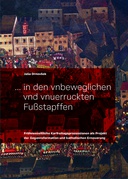Explore

… in den vnbeweglichen vnd vnuerruckten Fußstapffen
Jaša Drnovšek
2020
0 Ungluers have
Faved this Work
Login to Fave
How can we explain the large number of Good Friday processions that characterised Catholic Europe from the 16th to the 18th century? Jaša Drnovšek presents these early modern performances as eminently political phenomena that could only exist against the background of the Counter-Reformation and Catholic renewal. In doing so, he takes up Joachim Küpper's theory of cultural production, according to which culture can be seen as a virtual network. In his comparative cultural-historical study, Drnovšek takes an in-depth look at the history of the Capuchin and Jesuit orders, both of which contributed significantly to the rise of Good Friday processions. The Škofjeloški pasijon, the oldest Slovenian drama, whose revived performance tradition has been under UNESCO protection since 2016, plays here a special role.
This book is included in DOAB.
Why read this book? Have your say.
You must be logged in to comment.
Rights Information
Are you the author or publisher of this work? If so, you can claim it as yours by registering as an Unglue.it rights holder.Downloads
This work has been downloaded 76 times via unglue.it ebook links.
- 76 - pdf (CC BY) at Unglue.it.
Keywords
- capuchins
- Counter-Reformation
- Cultural Studies
- Early Modern Ages
- Eastern Europe
- Europe
- Geographical Qualifiers
- history of ideas
- Jesuits
- jezuiti
- kapucini
- procesije
- processions
- protireformacija
- Škofja Loka
- Slovenia
- Society & culture: general
- Society & Social Sciences
- Southeast Europe
- thema EDItEUR::1 Place qualifiers::1D Europe::1DX Southeast Europe::1DXV Slovenia
- thema EDItEUR::J Society and Social Sciences::JB Society and culture: general::JBC Cultural and media studies::JBCC Cultural studies::JBCC9 History of ideas
- Yugoslavia & former Yugoslavia
- zgodnji novi vek
Links
DOI: 10.3986/9789610505082Editions

